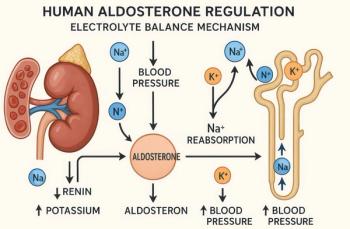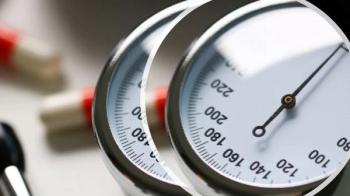
What's New in the Treatment of Hypertension?
An oral renin inhibitor, aliskiren, recently became available. Does it have any advantages over angiotensin-converting enzyme (ACE) inhibitors or angiotensin receptor blockers (ARBs)?
Q: An oral renin inhibitor, aliskiren, recently became available. Does it have any advantages over angiotensin-converting enzyme (ACE) inhibitors or angiotensin receptor blockers (ARBs)?
A: Aliskiren represents the fourth class of antihypertensive agents to lower blood pressure through actions on the renin-angiotensin system (RAS). The other 3 classes are b-adrenergic blockers, ACE inhibitors, and ARBs. However, with these earlier agents, RAS blockade remains incomplete because of compensatory increases in plasma renin activity (PRA) that result from interruption of the negative feedback effect that angiotensin II has on renin release. In addition, the substantial proportion of angiotensin II generated via non-ACE pathways limits the effectiveness of ACE inhibitors.
Increased PRA is associated with target organ damage; with ARBs, the reactive rise in PRA may actually represent a cardiovascular risk factor. Because PRA is the initial event in the cascade of reactions that results in the generation of angiotensin II, it has long been recognized that PRA is the optimal target for RAS blockade.
Earlier efforts to develop effective renin inhibitors did produce several agents, but these required intravenous administration and were therefore not appropriate for widespread clinical use. They were also limited by developmental costs, short duration of action, and relatively weak antihypertensive effects. These problems have apparently been overcome in the development of aliskiren.
Evidence of efficacy. In one study of 672 patients who were randomly assigned to receive aliskiren (150, 300, or 600 mg/d) or placebo for 8 weeks, significant reductions in blood pressure were observed with all dosages of aliskiren compared with placebo.1 Aliskiren also significantly reduced mean 24-hour ambulatory blood pressure, and trough-to-peak ratios for all doses were sufficiently significant to suggest once-daily effectiveness. All 3 dosages of aliskiren reduced PRA, even though renin concentrations increased in a dose-dependent manner.
Although the 600-mg dose of aliskiren induced larger blood pressure reductions than the 300-mg dose, the differences were not statistically significant. Similar observations in other studies during the developmental process resulted in the drug being approved at dosages of 150 and 300 mg/d.
Blood pressure-lowering effects with aliskiren were similar to or greater than those seen with hydrochlorothiazide (12.5 to 25 mg/d) and similar to or greater than those of such agents as ramipril (5 to 10 mg/d), valsartan (160 to 320 mg/d), and losartan (100 mg/d). Significant additional blood pressure-lowering effects were observed when aliskiren was administered in combination with these agents.2
Pharmacokinetics. Aliskiren is poorly absorbed from the GI tract; the bioavailability of a typical dose is only 2.5%. Absorbed aliskiren appears to be eliminated via the hepatobiliary route and to some extent through oxidative metabolism.3
The pharmacokinetics of this agent have not been evaluated in patients younger than 18 years; however, in adults they appear to be similar in white, African American, and Japanese patients. The pharmacokinetics of aliskiren do not appear to be affected by the presence of mild to severe renal insufficiency-at least not to an extent that would require dose adjustment.
Overall, aliskiren appears to have a relatively low potential for drug interactions. Nonetheless, as with any new agent, clinicians should carefully review and familiarize themselves with the information in the package insert, including the drug's pharmacokinetics, potential drug interactions, toxicities, and potential contraindications.
Caveats and future prospects. A recent review of multiple clinical trials of aliskiren involving more than 5000 patients with mild to moderate hypertension has produced some concern. Although aliskiren was as effective at lowering blood pressure as ACE inhibitors, ARBs, and diuretics, greater increases in plasma renin concentrations were observed with aliskiren because, as with other agents that block the RAS, inhibition of plasma renin was incomplete.
Renin inhibitors do not block the production of renin; they block plasma renin activity. In fact, plasma renin concentrations (predominantly prorenin) increase with the administration of a direct renin inhibitor. The rise in prorenin levels with aliskiren is greater than that seen with either an ACE inhibitor or an ARB. Some experts have expressed concern that the greater reactive increases in plasma renin concentration could offset the drug's ability to lower blood pressure, especially in high-renin states such as renovascular hypertension or severe to malignant hypertension.4
Although the blood pressure-lowering effects of aliskiren are comparable, and in some cases superior, to those of other antihypertensive drugs when these are compared as monotherapy, keep in mind that the majority of patients with hypertension require 2 or more drugs to achieve and maintain goal blood pressure. Although all RAS blockers appear to offer similar efficacy as monotherapy, further clinical trials are needed to clarify the blood pressure effects of these agents when combined with a diuretic or calcium antagonist.
Remember, too, that older RAS-blocking agents, such as ACE inhibitors and ARBs, provide more cardiovascular risk reduction and benefits beyond blood pressure-lowering than do regimens that do not include an RAS blocker. The future role of aliskiren may well be determined by the results of large, carefully controlled clinical trials that focus on cardiovascular and renal outcomes other than the antihypertensive effects of the agents involved.
Finally, we still do not know whether there are clinical settings in which aliskiren might offer an advantage over ACE inhibitors or ARBs (assuming that all RAS blockers have similar efficacy as monotherapy as well as in combination with a thiazide diuretic or calcium antagonist). Aliskiren has a prolonged duration of action, which may be of benefit in patients who occasionally miss a daily dose of medication, but any potential benefit of this longer pharmacological action on other disease mechanisms will require appropriate outcome studies.
Aliskiren has virtually no adverse effects at dosages up to 300 mg/d. At higher dosages, significant diarrhea has been noted. However, this agent has not been associated with such adverse effects as cough or angioedema, which sometimes occur with ACE inhibitors. Thus, it appears that aliskiren, when used as monotherapy or in combination with other agents, provides blood pressure-lowering effects comparable to those of an ACE inhibitor or an ARB. Given the information currently available, the likelihood of a study demonstrating a major difference in the effects of aliskiren and other therapies on the rate of progression of target organ disease appears small. Aliskiren does offer a new approach to antagonism of the RAS and, as such, provides a useful new addition to the physician's therapeutic armamentarium for the treatment of mild to moderate hypertension.
References:
REFERENCES:
1.
Oh BH, Mitchell J, Herron JR, et al. Aliskiren, an oral renin inhibitor, provides dose-dependent efficacy and sustained 24-hour blood pressure control in patients with hypertension.
J Am Coll Cardiol
. 2007;49:1157-1163.
2.
O'Brien E, Barton J, Nussberger J, et al. Aliskiren reduces blood pressure and suppresses plasma renin activity in combination with a thiazide diuretic, an angiotensin-converting enzyme inhibitor, or an angiotensin receptor blocker.
Hypertension
. 2007;49:276-284.
3.
Frampton JE, Curran MP. Aliskiren: a review of its use in the management of hypertension.
Drugs
. 2007;67:1767-1792.
4.
Sealey JE, Laragh JH. Aliskiren, the first renin inhibitor for treating hypertension: reactive renin secretion may limit its effectiveness.
Am J Hypertens
. 2007; 20:587-597.
Newsletter
Enhance your clinical practice with the Patient Care newsletter, offering the latest evidence-based guidelines, diagnostic insights, and treatment strategies for primary care physicians.



















































































































































































































































































